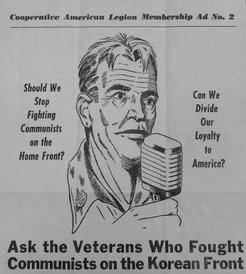Grassroots Veterans
The American Legion and Conservative Change in California, 1945-2000
Marvin Theo Bähr (completed PhD Project, 2019)


© Mudd Manuscript Library, Princeton
The American Legion was the largest and most influential veterans’ organization in the twentieth century United States. Founded in the wake of World War I, the Legion quickly became more than a special interest group lobbying for the expansion of veteran benefits as a means of honoring soldiers’ service and facilitating their reintegration into society. Beyond the core mandate of war veteran representation, Legion leaders built up a strong presence in conservative politics and exerted considerable influence on municipal, state, and federal governments. At the peak of its powers, the Legion was one of the most trusted civic organizations in the country and successfully sold conservative politics as common sense patriotism.
The political activity of Legionnaires was underpinned by the conviction that service for the nation did not end with a soldier’s demobilization from a theatre of war. Instead, it continued in the homeland, which had to be safeguarded from alien ideologies and subversion. Legion officials called for law and order, patriotic pride, and a sustained fight against Communist and New Left influences. During the 1950s and 1960s especially, Legion initiatives sought to preserve American tradition in a rapidly changing country considered to stand on unstable moral footing. Legionnaires, in other words, joined the burgeoning conservative movement to safeguard moral values espoused by a large subset of white middle class suburbanites, who opposed pacifism, collectivism, and multiculturalism.
“The history of California”, novelist Wallace Stegner once remarked, “is American history in extremis.” For my purposes, the focus on California facilitates a close look at the way political polarization afflicted U.S. society during the postwar years. In the Golden State, both left and right garnered strong support and were locked in symbiotic combat. What Legionnaires meant with notions such as Americanism materialized in demarcation from leftist practices deemed unbearable. The political environment of California, characterized by a long history of leftist organizing, strong unions, Hollywood liberals, campus activism, and minority rights advocacy, permanently challenged Legion activists to create or respond to political controversies. Since the late 1960s, however, their conservative campaigns persuaded the citizens of California less and less. Vis-à-vis a prolonged membership crisis, the late twentieth century American Legion, then, changed course and appropriated some elements of 1960s cultural liberalization to address its membership woes. As a result, previously marginalized Legionnaires, in particular women veterans and veterans of color, used the opportunity to climb the ranks and share in the Legion’s power. An organization historically devoted to defend the status quo, after all, discovered the merits of adapting to increased racial tolerance, gender equality, and cultural diversity, albeit slowly, selectively, and imperfectly. The Legion remained conservative, only what the term conservative signified had changed.